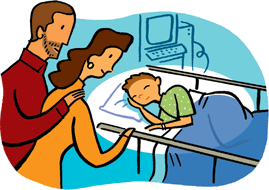The image-guided biopsy is done by the Interventional Radiology staff in the Department of Pediatric Radiology at UPMC Children’s Hospital. Interventional Radiology performs minimally-invasive procedures with image guidance.
The procedure will be done in either the Interventional Radiology suite or a CT scan room. In the room will be a pediatric interventional radiology doctor, who will do the image-guided biopsy, as well as pediatric radiology technologists and nurses who will help the doctor. Other medical and imaging staff also may be present to help during the procedure. The doctor and other staff will be wearing hats (like shower caps), masks, gloves and lead aprons during the procedure. The lights will be dim inside the room.
If the biopsy is done in the Interventional Radiology suite, inside the room you will see an X-ray machine, an ultrasound machine, a long table and television screens. You might explain to your child that the X-ray machine is a large camera for taking pictures that will be seen on the TV screens.
If the biopsy is done in a CT scan room, inside the room you will see the CT machine with a long table that will slide into the tube-shaped or tunnel-like scanner where the camera is located. If your child has any questions, the staff will be happy to answer them before the procedure.
- You may accompany your child to the Interventional Radiology suite or CT room and give support and comfort until the procedure begins or until sedation medication is given.
- Your child will be asked to lie down on the table and a “seat belt” will be placed around your child to help him or her keep still during the procedure.
- Once the procedure begins, you will be shown to the main waiting area. You may either stay there or ask the desk staff for a pager in case you would like to get something to eat or drink in the cafeteria, Pop Stop or gift shop.
- The area of your child’s body on which the biopsy is to be done will be examined either using CT, X-ray, or ultrasound images at this time. These images will determine the exact location on your child’s body where the biopsy will be done.
- A special soap will be used to clean the area on your child’s body where the biopsy will be done.
- Your child’s body will be covered with a sterile sheet everywhere but the spot where the biopsy will be done. The sheet will keep that area of your child’s body clean and germ-free.
- Your child will be given medication through a needle to numb the area around the spot where the biopsy will be done.
- The doctor will pass a special type of needle through the skin in the chosen area.
- When the doctor removes the needle, it will contain a small piece of tissue, called a sample.
- A pathologist (a doctor who studies samples in the lab) may come to examine the tissue to make sure an adequate sample has been taken. The pathologist will then take the biopsy tissue sample to the lab to be tested.
- Once the procedure is finished, the doctor may place a bandage over the area on your child’s body where the biopsy was done.
- Your child may need to have a period of recovery if sedation or anesthesia is used.
As a parent, you may have concerns about radiation exposure. Children’s Hospital takes every precaution to make sure your child is safe. Our goal is to do the procedure correctly and thoroughly, while exposing your child to the smallest amount of radiation necessary to take the X-rays.
- Advances in equipment and film have lowered the amount of radiation your child will receive.
- All of the equipment is inspected regularly.
- Parts of the body that are not being X-rayed will be protected with a lead cover or apron when possible.









 At
At